Many fly fisherman/woman have never been fly fishing in the winter months or even late fall. Why? Well, because it’s cold, and usually they don’t think there’s much action. Or, they’d rather hang out on their couch watching their favorite football or hockey team while munching on some snacks and drinking a cold beverage. Or, maybe they’re working at home, reducing that honey-do list so they have more time when the weather warms to fish. Or, maybe they’re taking this time to tie more flies to replenish their fly boxes. We won’t harp on any of these excuses, except maybe the football thing… if you’re going to watch a sport, go with hockey. As the old saying goes, hockey is like football, but for men. We’re just sayin’!
Fly fishing during the much colder months offers its’ own rewards, and there are many! In addition, you’ve got to adapt to the conditions to make the most out of your excursion. So, we’re going to give to a few reasons to giddy up and go, as well as several tactical changes and tips to help put the odds in your favor.
The Reasons to Fly Fish in the Winter are Priceless
Reason #1 – Solitude
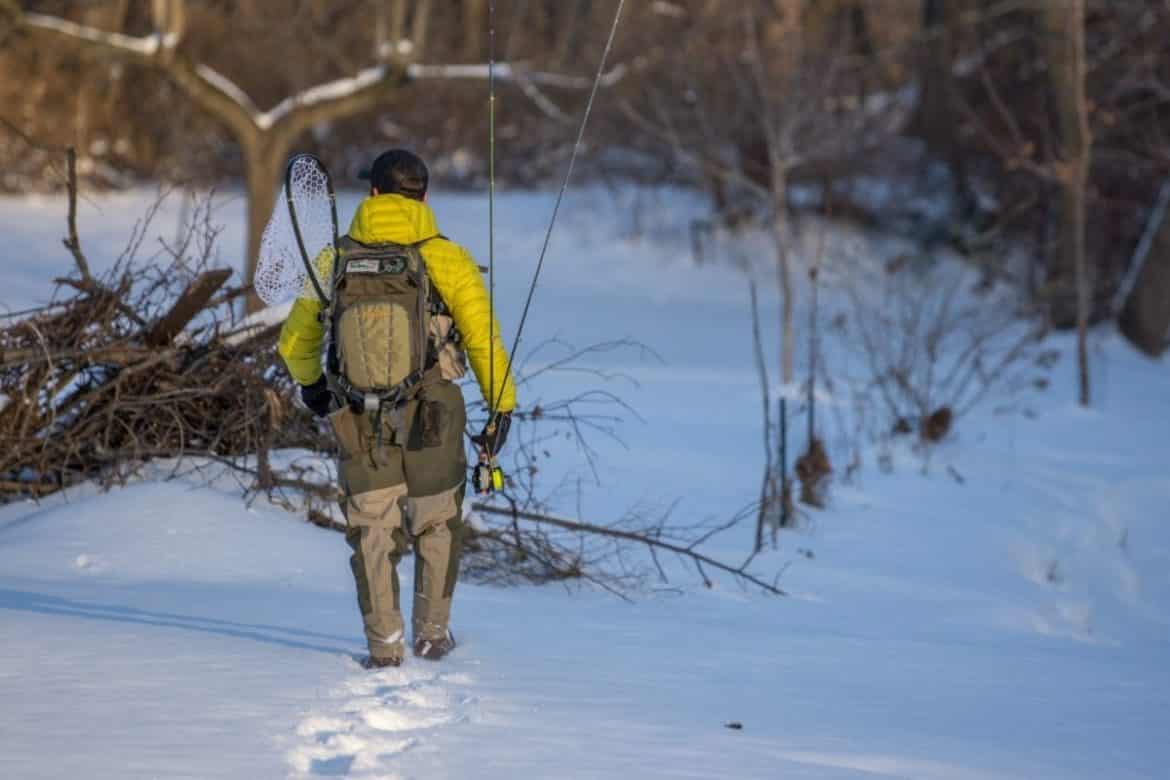
Fly fishing in the winter is not for everyone. However, fly fisher-people who are attracted to it because of the peace and quiet they find and a time to regenerate the soul should be some of the ones who take advantage of winter fly fishing. Of course it’s cold, but that means there are far fewer people on the water. No canoers, no tubers, no kayakers, and far fewer people in drift boats and long boats to cause commotion while you are there… alone (or maybe with a buddy)… just you and the river and fish, quiet, no stress, no honey-do list, peaceful. Sound great? You bet it is!
Reason #2 – Beauty
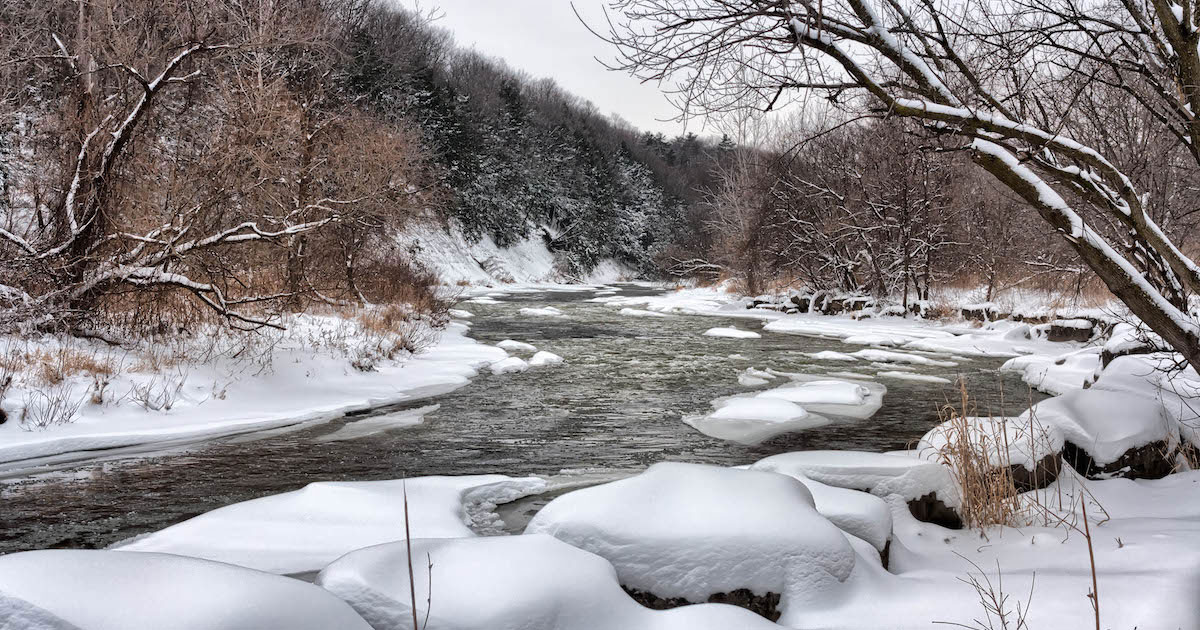
The waterways during the spring and summer bring beauty, yes, but there is a certain unique beauty offered during the fall and winter. It is crisp. It is quiet, with not much sound than the cold clear river running through the landscape. And because there is almost no traffic on the water, the wildlife tend to come out more often. I’ve seen more wildlife when fly fishing in the winter than I have at any other time, and catching the critters in action is one of the reasons why I love the sport to begin with. Last, if there is snow on the ground, everything brightens up. It really is picturesque! Be ready to take a few photos because you’ll see some of the most beautiful scenery ever. Heaven on earth.
Reason #3 – Catching Fish
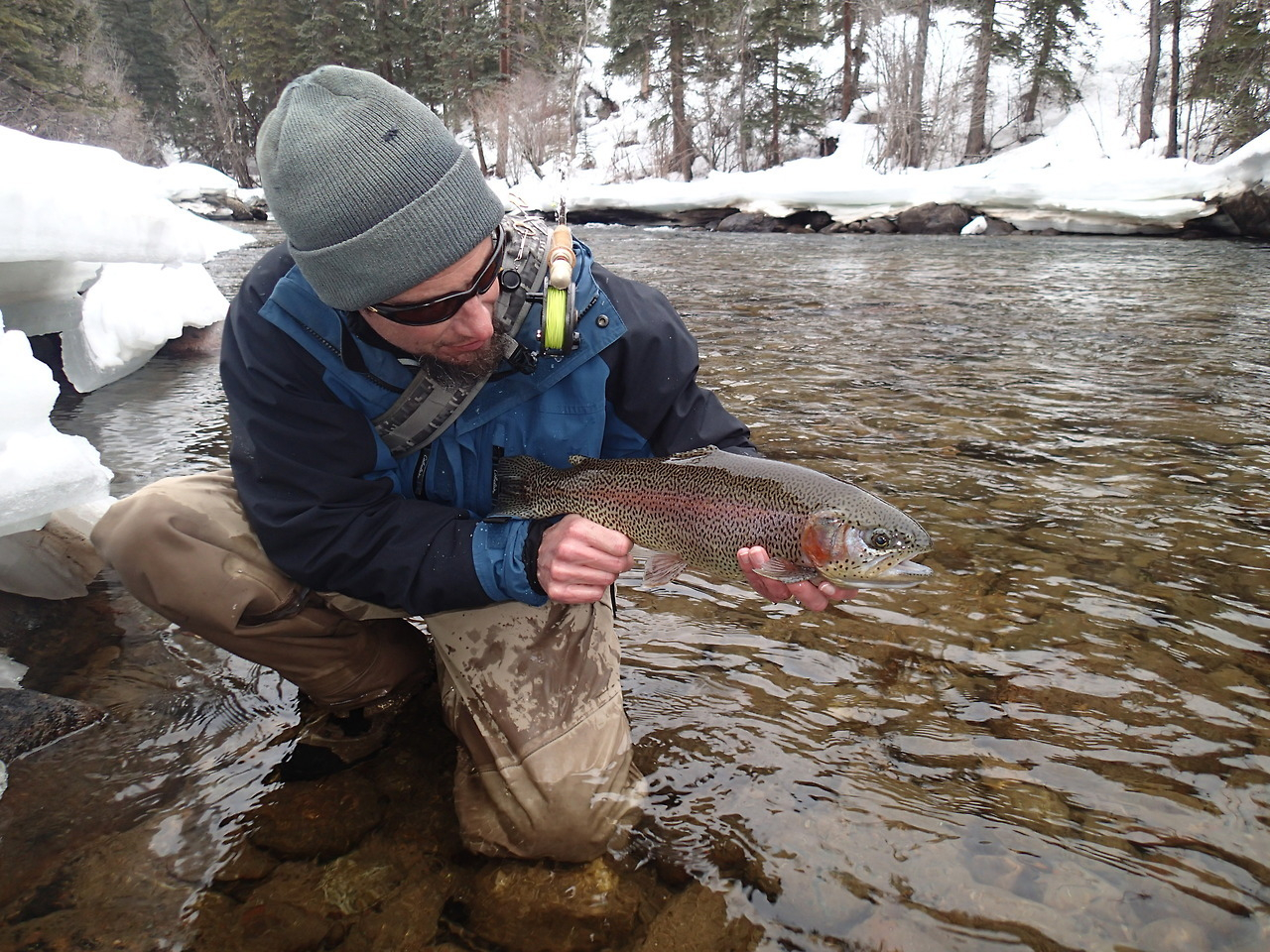
Yes, you can catch fish when it is cold. Maybe even some of the largest fish you’ll ever catch. Fly fishing during the spring and summer months can deliver large fish, no question. But depending on where you fish, catching a big one means you’re fishing at night. While I enjoy that as well, it’s not the same. You see larger fish, being predators, even though they’re moving slower in the winter will attack a fly more often as long as you’re changing your tactics to fit the conditions. I’ve seen more large fish caught during the day when it’s cold, than I have any other time of year.
Which bring us to those tricks and tactics you’ll need to have a better chance to catch those fish.
Winter Fly Fishing Requires A Tactical Change
Tactical Change #1 – The Weather
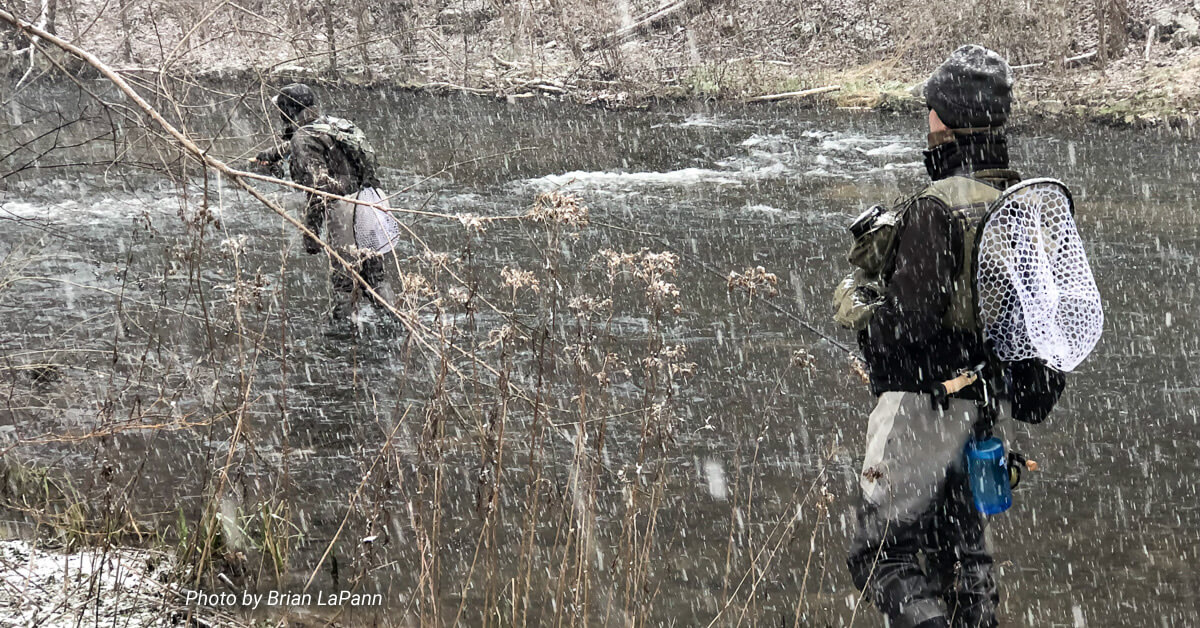
I’ve read many articles which talk of how the weather impacts winter fly fishing. Some say don’t fish when it’s bitter cold. Some say fishing is better during cloudy weather. And then other articles say the opposite. What I know, and have experienced is the more you’re on the water the better your chances are of catching fish. Fact is, the fish are more prone to the water temperature and what is going on in and on the water that the other environmental nuances. For cold-weather fly fishing, ideal water temperatures will be above 40 degrees. Here is when the bugs will even move in the water and stimulate the fish to feed.
Sun or clouds, outside temp being warmer or cold, not so much… even on brutally cold bright sunny days you can catch fish. Paying attention to the weather is important. Windy days suck; the wind chill makes cold even colder and can be dangerous, and casting is a bitch even with heavier streamers. Snowy days can be great; it adds to the beauty, and can stimulate the fish. As long as you’re prepared for the cold, just get out there and swing your rod!
Tactical Change #2 – When To Venture Out
Unlike the Spring and Summer, waking up early to get a head start is pretty much a waste of your time. So go ahead, sleep in. Have that extra cup of coffee. Enjoy a hearty breakfast. Maybe even “nudge” your significant other. Then, once you’re energized and ready to go, get out there around 10:30 – 11:00 a.m.-ish. Just like you, when it’s cold the fish don’t like to get up too early either. Again, it is a function of the water temperatures being too cold earlier in the day. As such, your best opportunity for fly fishing in the winter will dwindle later in the afternoon as the water cools. What time? I don’t know. Take a water temp reading. If the water is 40 degrees or less the fish activity will likely begin to fade.
Tactical Change #3 – Location
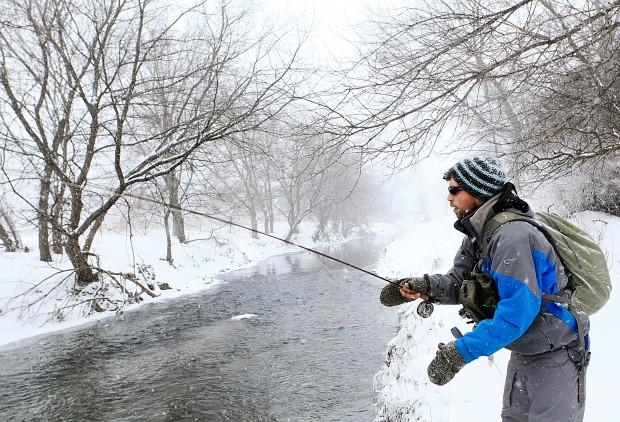
You’re told in the warmer months to fish right next to the river banks, against downed logs, and in relatively fast moving riffles and seams, right? Yeah, forget all that. Winter fly fishing is most productive when you fish slower, deeper water (however I will contradict myself in a moment). This is where the fish congregate most often. Why? Because their metabolism has slowed down greatly they will seek those areas where they have to expend the least amount of energy. Look for deeper pools and shelfs. Again, it’s about water temperature. And here is where I contradict myself… if the sun is out long enough to warm less deep areas, then look there. The bugs will be active and so will the fish. Remember, trout are opportunistic feeders and will move to where the bugs are, warm or colder water.
Tactical Change #4 – Your Flies
O.k., so the fish are most often deeper so dry flies are out right? Well, not exactly. The conditions will dictate the best flies to use and try; dry flies, nymphs, and/or streamers.
Dry Flies –
There are two primary flies that still will hatch during the colder months; midges and blue-winged olives. The keys to their hatching are – you guessed it, water temperature and yes, air temperature. While these hatches are definitely sporadic, they will occur during those warmer days. A large portion of a trout’s diet during the winter are midges in their various stages of development.
If you catch on of these warm days and see a few rising fish, then your presentation has to be even better than during a summer hatch. Use a longer 6x leader and tippet and do your best to make the fly land “naturally” on the water. Winter fish are even more skiddish than summer fish, and you almost have to land the fly on top of them to get a reaction. Again, even for rising trout, in the winter you won’t often find them in the shallower water, but in the tailwaters. These waters tend to be warmer and slower.
It is safe to say though, that unless you see an active hatch and or rising trout, your best bets are nymphs or streamers.
Nymphs –
if your skilled enough to nymph fish without a strike indicator then use a heavier tippet and maybe even a lighter grain sinking line. If not, still go with a heavier leader/tippet and use split shot. The key is to get the nymph down deep to where the fish are and at the right height off the bottom to pass through the fish. It is also important to reduce your casting interval. Let the nymph travel a greater distance under water to allow the fish time to react. Then wait a bit longer before you cast again to the same water.
Streamers –
For fly fishing in the winter, I’ve had the most success fishing with streamers. To be honest, the color of the fly isn’t as critical as the speed with which to strip. I’ve had success with white streamers as well as darker colored ones. The key is once you cast, let the fly dead drift a bit then slowly begin to strip. I first learned this the hard way when I was fishing with a white streamer, stripping like I do during the summer… nothing. My buddy, watching and chuckling, told me to get out of the way and let a pro show me how it’s done. Uh huh, I thought, knock yourself out. Using the same streamer, he cast to where I did, but stripped about 75% slower than I did. Bam! On the second cast he hit and landed a nice 12 inch brown… on the fifth cast, again, BAM! He hooked and landed a 21 inch brown. He just smiled. Son of a bitch! Lesson learned.
Tactical Change #5 – Your Gear
It’s cold in the winter. Dress accordingly. In layers. Sweating is bad. If you start to sweat, stop and cool down, and take off a layer. Wear insulated wader liners (BTW, Reddington makes a wicked pair for about $50). Wear heavy enough socks to keep your feet warm but not too tight that you can’t wiggle your toes. Ideally your boots should have rubber soles, not felt… felt tends to collect clumps of snow which makes it difficult to walk.
Tactical Change #6 – Safety
Fly fishing in the winter carries its’ own safety concerns, and much should be common sense, but if you’ve never done it before, well, that common sense may not come naturally. Be extremely cautious. Getting wet in freezing temperatures can quickly cause hypothermia – not good. Never wade in water deeper than mid-thigh. Never stand on an open ice shelf with rushing water underneath. Never stand on a snow or ice-covered river bank – kick it off down to the ground. Again, use common sense.
For most of us, we reserve fly fishing for the Spring and Summer when the weather is accommodating and we believe our chances of success are highest. However, if you’ve never been fly fishing in the colder months of November through March, you are missing out on some of the best times to be out there. The solitude, the beauty, and of course the fishing. And it isn’t harder, just different. Your tactics will need to change but I guarantee you it will be most memorable, some of the best time you’ll spend doing what you love the most.
Go ahead, tie one on!















































